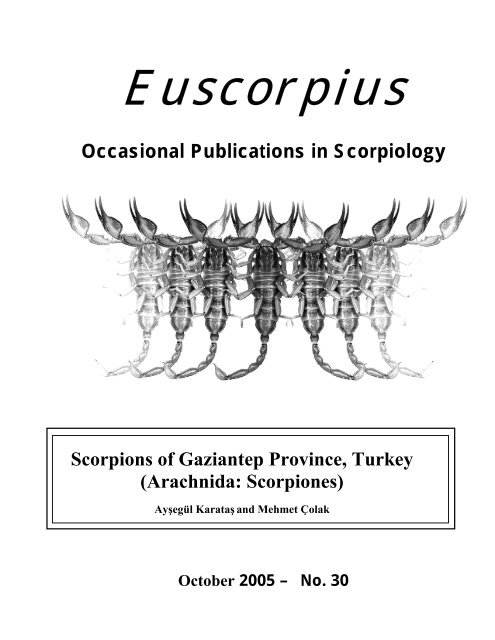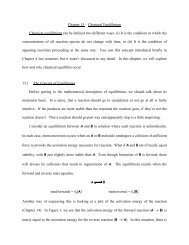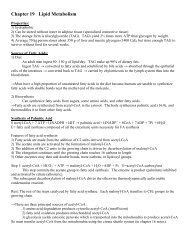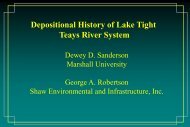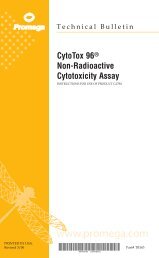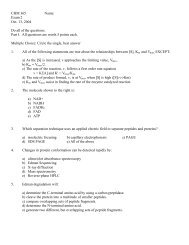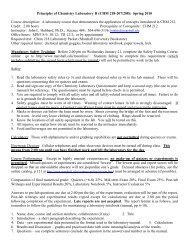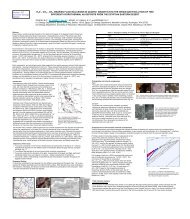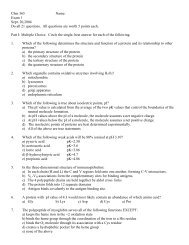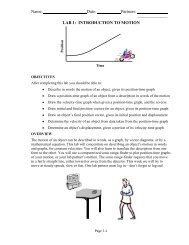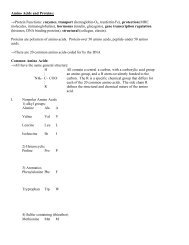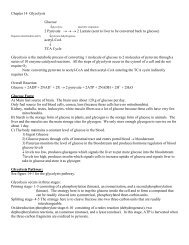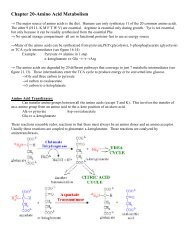Scorpions of Gaziantep Province, Turkey - Marshall University
Scorpions of Gaziantep Province, Turkey - Marshall University
Scorpions of Gaziantep Province, Turkey - Marshall University
You also want an ePaper? Increase the reach of your titles
YUMPU automatically turns print PDFs into web optimized ePapers that Google loves.
Euscorpius<br />
Occasional Publications in Scorpiology<br />
<strong>Scorpions</strong> <strong>of</strong> <strong>Gaziantep</strong> <strong>Province</strong>, <strong>Turkey</strong><br />
(Arachnida: Scorpiones)<br />
Ayşegül Karataş and Mehmet Çolak<br />
October 2005 – No. 30
Euscorpius<br />
Occasional Publications in Scorpiology<br />
EDITOR: Victor Fet, <strong>Marshall</strong> <strong>University</strong>, ‘fet@marshall.edu’<br />
ASSOCIATE EDITOR: Michael E. Soleglad, ‘soleglad@la.znet.com’<br />
Euscorpius is the first research publication completely devoted to scorpions (Arachnida:<br />
Scorpiones). Euscorpius takes advantage <strong>of</strong> the rapidly evolving medium <strong>of</strong> quick online<br />
publication, at the same time maintaining high research standards for the burgeoning field <strong>of</strong><br />
scorpion science (scorpiology). Euscorpius is an expedient and viable medium for the<br />
publication <strong>of</strong> serious papers in scorpiology, including (but not limited to): systematics,<br />
evolution, ecology, biogeography, and general biology <strong>of</strong> scorpions. Review papers, descriptions<br />
<strong>of</strong> new taxa, faunistic surveys, lists <strong>of</strong> museum collections, and book reviews are welcome.<br />
Derivatio Nominis<br />
The name Euscorpius Thorell, 1876 refers to the most common genus <strong>of</strong> scorpions in the<br />
Mediterranean region and southern Europe (family Euscorpiidae).<br />
Euscorpius is located on Website ‘http://www.science.marshall.edu/fet/euscorpius/’ at<br />
<strong>Marshall</strong> <strong>University</strong>, Huntington, WV 25755-2510, USA.<br />
The International Code <strong>of</strong> Zoological Nomenclature (ICZN, 4th Edition, 1999) does not accept<br />
online texts as published work (Article 9.8); however, it accepts CD-ROM publications (Article<br />
8). Euscorpius is produced in two identical versions: online (ISSN 1536-9307) and CD-ROM<br />
(ISSN 1536-9293). Only copies distributed on a CD-ROM from Euscorpius are considered<br />
published work in compliance with the ICZN, i.e. for the purposes <strong>of</strong> new names and new<br />
nomenclatural acts. All Euscorpius publications are distributed on a CD-ROM medium to the<br />
following museums/libraries:<br />
• ZR, Zoological Record, York, UK<br />
• LC, Library <strong>of</strong> Congress, Washington, DC, USA<br />
• USNM, United States National Museum <strong>of</strong> Natural History (Smithsonian Institution),<br />
Washington, DC, USA<br />
• AMNH, American Museum <strong>of</strong> Natural History, New York, USA<br />
• CAS, California Academy <strong>of</strong> Sciences, San Francisco, USA<br />
• FMNH, Field Museum <strong>of</strong> Natural History, Chicago, USA<br />
• MCZ, Museum <strong>of</strong> Comparative Zoology, Cambridge, Massachusetts, USA<br />
• MNHN, Museum National d’Histoire Naturelle, Paris, France<br />
• NMW, Naturhistorisches Museum Wien, Vienna, Austria<br />
• BMNH, British Museum <strong>of</strong> Natural History, London, England, UK<br />
• MZUC, Museo Zoologico “La Specola” dell’Universita de Firenze, Florence, Italy<br />
• ZISP, Zoological Institute, Russian Academy <strong>of</strong> Sciences, St. Petersburg, Russia<br />
• WAM, Western Australian Museum, Perth, Australia<br />
• NTNU, Norwegian <strong>University</strong> <strong>of</strong> Science and Technology, Trondheim, Norway<br />
Publication date: 24 October 2005
Euscorpius — Occasional Publications in Scorpiology. 2005, No. 30<br />
<strong>Scorpions</strong> <strong>of</strong> <strong>Gaziantep</strong> <strong>Province</strong>, <strong>Turkey</strong><br />
(Arachnida: Scorpiones)<br />
Ayşegül Karataş and Mehmet Çolak<br />
Department <strong>of</strong> Biology, Faculty <strong>of</strong> Science and Arts, Niğde <strong>University</strong>, 51200 Niğde, <strong>Turkey</strong>;<br />
karatash@nigde.edu.tr<br />
Summary<br />
This study includes the results <strong>of</strong> the field studies in <strong>Gaziantep</strong> <strong>Province</strong>, which is located in the south-southeastern<br />
Anatolia, <strong>Turkey</strong>. In 1998–2005, 112 scorpion specimens were collected in this area. They belong to five species <strong>of</strong><br />
the family Buthidae (Androctonus crassicauda, Compsobuthus matthiesseni, Leiurus quinquestriatus, Mesobuthus<br />
eupeus, M. nigrocinctus), one species <strong>of</strong> Iuridae (Calchas nordmanni), and one species <strong>of</strong> Scorpionidae (Scorpio<br />
maurus fuscus). Information about these species is provided; ecological notes are included.<br />
Introduction<br />
<strong>Gaziantep</strong> <strong>Province</strong> is situated in the southsoutheastern<br />
<strong>Turkey</strong> within altitudes ca. 400–600 m asl.<br />
In the south, this province is limited by a small portion<br />
<strong>of</strong> the Turkish-Syrian border (Fig. 1). In the west <strong>of</strong> the<br />
province, the Nur Mountains, and in the north, the Taurus<br />
Mountains are located. Generally Submediterranean<br />
and continental climate prevails in the area but near the<br />
Syrian border (and especially near the Euphrates River)<br />
the eremial faunal components are present. Pistachio<br />
gardens extend between <strong>Gaziantep</strong> and Şanli Urfa Plateaus.<br />
Well-developed reddish pine stands occur on the<br />
<strong>Gaziantep</strong> Plateau (Atalay, 2002).<br />
The goal <strong>of</strong> this study was to establish the composition<br />
<strong>of</strong> scorpion species <strong>of</strong> <strong>Gaziantep</strong> <strong>Province</strong> and to<br />
contribute to the further knowledge <strong>of</strong> Turkish fauna.<br />
Material and Methods<br />
Field studies were conducted between 2001 and<br />
2005 (only one specimen was collected in 1998). In total,<br />
112 specimens were collected. All specimens were<br />
collected under the stones during the day time or by using<br />
UV lamp at night between 08:00 pm and 11:00 pm.<br />
All specimens are preserved in 70% ethyl alcohol and<br />
deposited in the scorpion collection at the Zoology Department<br />
<strong>of</strong> Niğde <strong>University</strong> (ZDNU). Species were<br />
identified using a stereomicroscope Olympus SZX9.<br />
Results<br />
Seven species, belonging to the family Buthidae<br />
(five), Iuridae (one), and Scorpionidae (one), were collected<br />
as listed below.<br />
Family Buthidae<br />
Androctonus crassicauda (Olivier, 1807)<br />
Specimens examined: <strong>Gaziantep</strong>: Nizip,<br />
01.VIII.1998: 1 ♀ (ZDNU 1998/262), 20 km north <strong>of</strong><br />
<strong>Gaziantep</strong>-Nizip road, 07.VIII.2003: 1 ♂ (ZDNU<br />
2003/566), old road from Şehitkâmil to Nizip (5 th km),<br />
23.VII.2003: 2 ♀♀ (ZDNU 2003/469, 536), Şehitkâmil,<br />
2 km west <strong>of</strong> old Nizip road, 23.VII.2003: 1 ♀ (ZDNU<br />
2003/479), road from <strong>Gaziantep</strong> to Nizip (20 th km),<br />
22.VIII.2003: 1 ♀ (ZDNU 2003/567), Şahinbey, south<br />
<strong>of</strong> Kızılhisar Village, 10.VII.2003: 1 ♂ (ZDNU<br />
2003/477), new road from Şehitkâmil to Nizip (c. 15 th<br />
km), 25.VIII.2003: 1 ♂ (ZDNU 2003/478), Şehitkâmil,<br />
Y. Beylerbeyi (Serkenez) Village, 18.VII.2003: 1 ♂, 1 ♀<br />
(ZDNU 2003/480, 537), Karkamış, Kızılpınar Village,<br />
15.VIII.2004: 1 ♀ (ZDNU 2004/752), Nizip,<br />
25.VI.2003: 1 ♀ (ZDNU 2003/554), Nizip, Mağaracık<br />
Village, artificial caves (ruins) (480 m a.s.l.),<br />
27.IX.2002: 2 ♀♀ (ZDNU 2002/346, 347).<br />
Comments: This species is known from the Sinai<br />
Peninsula (Egypt) across the entire Middle East (Israel,<br />
Jordan, Syria, <strong>Turkey</strong> (southeastern Anatolia), Iraq), the
2<br />
Euscorpius — 2005, No. 30<br />
Figure 1: <strong>Gaziantep</strong> <strong>Province</strong> and sampling localities: 1. <strong>Gaziantep</strong> <strong>University</strong>, 2.Şahinbey, 3. Akpınar, 4. Burç, 5. Budak, 6.<br />
Cevizli, 7. Sarıbaşak (Ispatırın), 8. Güllüce and Ellezi Mountain, 9. Günbulur, 10. Karataş, 11. Kızılhisar, 12. Mahraman, 13.<br />
Mazmakor, 14. Sarısalkım, 15. Yeşilkent, 16. Şehitkâmil, 17. Dülük, 18. Karahöyük, 19. İbrahimli, 20. Saray, 21. Y. Beylerbeyi<br />
(Serkenez), 22. Sinan, 23. Türkyurdu, 24–25. <strong>Gaziantep</strong> (Şehitkâmil)–Nizip road, 26. <strong>Gaziantep</strong>–Şehitkâmil road, 27. Karataş,<br />
28. Karkamış, 29. Kızılpınar, 30. Nizip, 31. Kocatepe, 32. Mağaracık, 33. Üçkubbe.<br />
Arabian Peninsula, Armenia, Azerbaijan, and Iran (Fet<br />
& Lowe, 2000). Vachon (1951) reported A. crassicauda<br />
from Elazığ, Malatya, Mardin, and Şanli Urfa provinces.<br />
We found this species commonly in southeastern Anatolia,<br />
but it has not been known from <strong>Gaziantep</strong>. However,<br />
Crucitti & Vignoli (2002) recorded it probably from <strong>Gaziantep</strong><br />
(?). This xerophilic species is common in <strong>Gaziantep</strong>,<br />
especially in the lowland in the southern half <strong>of</strong><br />
this province. The specimens were collected by turning<br />
rocks, under stones near pistachio gardens and farmland<br />
in the lowland, or in the mountainous area with scarce<br />
vegetation, and also in crevices in two artificial caves far<br />
away from human settlements. Two specimens were<br />
found in the walls inside inhabited houses made <strong>of</strong> sundried<br />
bricks.<br />
Compsobuthus matthiesseni (Birula, 1905)<br />
Specimens examined: Road from <strong>Gaziantep</strong> to<br />
Şehitkâmil (between 10th and 20th km), 25.VIII.2003: 1<br />
♂ (ZDNU 2003/470), road from <strong>Gaziantep</strong> to Nizip,<br />
22.VIII.2003: 1 ♀ (ZDNU 2003/568), new road from<br />
Şehitkâmil to Nizip (c. 15th km), 25.VIII.2003: 2 ♀♀<br />
(ZDNU 2003/474/1-2); ibid (c. 20 th km), 07.VIII.2003: 1<br />
♂ (ZDNU 2003/520/1), 1 ♀ (ZDNU 2003/520/2), Şehitkâmil,<br />
Saray Village, 29.VII.2003: 1 ♂ (ZDNU<br />
2003/483).<br />
Comments: C. matthiesseni is known from central<br />
Iran (Kashan), southeastern <strong>Turkey</strong> and eastern Iraq, all<br />
in the Tigris-Euphrates drainage (Sissom & Fet, 1998;<br />
Fet & Lowe, 2000; Vignoli et al., 2003). Its first record<br />
from <strong>Turkey</strong> was given from Ergani (Diyarbekir) by<br />
Kovařík (1996). Later, Crucitti & Vignoli (2002) found<br />
this scorpion in Adıyaman. Specimens are uniformly<br />
light yellow as the lectotype described by Sissom & Fet<br />
(1998). Extreme sexual dimorphism is present. Males<br />
with slender bodies have highly elongated metasomal<br />
segments and pedipalps as compared to females. <strong>Scorpions</strong><br />
were found under stones among steppe vegetation<br />
near farmlands. One specimen <strong>of</strong> C. matthiesseni was<br />
collected by excavating a mouse burrow under a stone.<br />
A couple coded as 520-1 (♂) and 520-2 (♀) were taken<br />
from under the same stone. The time <strong>of</strong> their collection<br />
(August) could indicate mating season for this species.
Karataş & Çolak: <strong>Scorpions</strong> <strong>of</strong> <strong>Gaziantep</strong> <strong>Province</strong> 3<br />
Figure 2: An abnormal structure on telson <strong>of</strong> L. quinquestriatus<br />
(scale: 1 cm).<br />
Leiurus quinquestriatus (Ehrenberg, 1828)<br />
Specimens examined: near campus <strong>of</strong> <strong>Gaziantep</strong><br />
Univ., 02.VII.2003: 1 ♂ (ZDNU 2003/525), Şehitkâmil,<br />
west <strong>of</strong> Sinanköyü Village, 25.VIII.2003: 1 ♂ (ZDNU<br />
2003/472), 1 ♀ (ZDNU 2003/471), road from Nizip to<br />
Sinan Village (Şehitkâmil) (15 th km), 25.VII.2003: 2 ♀♀<br />
(ZDNU 2003/528/1-2), road from <strong>Gaziantep</strong> to Nizip<br />
(10 th km), 25.VIII.2003: 2 ♀♀ (ZDNU 2003/526/1-2), 1<br />
♂ (ZDNU 2003/527/2), ibid (10 th -20 th km),<br />
25.VIII.2003: ♀ (ZDNU 2003/560), ibid (15 th km),<br />
22.VIII.2003: 2 ♂♂ (ZDNU 2003/562/1, 562/3), 4 ♀♀<br />
(ZDNU 2003/562/2, 4-6), ibid (20 th km), 25.VIII.2003:<br />
♀ (ZDNU 2003/527/1), ibid (25 th km), 22.VIII.2003: ♂<br />
(ZDNU 2003/541), road from <strong>Gaziantep</strong> to Nizip, near<br />
Police Station, 22.VIII.2003: 1 ♀ (ZDNU 2003/570), old<br />
road from <strong>Gaziantep</strong> to Nizip (5 th km), 23.VII.2003: 3<br />
♂♂ (ZDNU 2003/462, 533/1-2), 2 ♀♀ (ZDNU<br />
2003/612/1-2), Şahinbey, between Burç Town and Akpınar<br />
Village, 13.VIII.2003: ♀ (ZDNU 2003/463),<br />
Şahinbey, Cevizli, Kıraçbağ, 29.VI.2003: 2 ♂♂ (ZDNU<br />
2003/464, 518), Şahinbey, Günbulur Village,<br />
21.VIII.2003: ♀ (ZDNU 2003/569), Şahinbey, Mahraman<br />
Village, 25.VI.2003: 1 ♂ (skin), (ZDNU 2003/579),<br />
02.VII.2003: 2 ♂♂ (ZDNU 2003/540/1, 577), 1 ♀<br />
(ZDNU 2003/540/2), ibid, environs <strong>of</strong> Burç Forest,<br />
02.VII.2003: 3 ♀♀ (ZDNU 2003/561, 574/1-2), Şahinbey,<br />
south <strong>of</strong> Kızılhisar Village, 10.VII.2003: ♂ (ZDNU<br />
2003/473), Şahinbey, east <strong>of</strong> Sarıbaşak (Ispatırın) Village,<br />
02.VII.2003: 1 ♀ (ZDNU 2003/467), Şahinbey,<br />
Sarısalkım Village, 23.VIII.2003: ♀ (ZDNU 2003/529),<br />
1 ♂ (ZDNU 2003/575), Şehitkâmil, near the Military<br />
Brigade, 23.VIII.2003: 3 ♂♂ (ZDNU 2003/523, 564/1,<br />
3), 1 ♀ (ZDNU 2003/564/2), Şehitkâmil, Military Brigade<br />
Forest, 23.VIII.2003: 1 ♂ (ZDNU 2003/578), Şehitkâmil,<br />
near the Celâl Doğan Spore Foundation,<br />
03.VII.2003: 1 ♂ (ZDNU 2003/519), 23.VIII.2003: 1 ♂<br />
(ZDNU 2003/576), Şehitkâmil, north <strong>of</strong> Industry Forest,<br />
23.VI.2003: 1 ♂ (ZDNU 2003/532), old road from Şehitkâmil<br />
to Nizip (between 3 rd and 7 th km), 23.VII.2003:<br />
2 ♀♀ (ZDNU 2003/468/1-2), 1 ♂ (ZDNU 2003/468/3),<br />
Şehitkâmil, between Dülük and Karahöyük villages,<br />
19.VII.2003: 1 ♀ (ZDNU 2003/539), Şehitkâmil, İbrahimli<br />
Village, 23.VIII.2003: 1 ♂ (ZDNU 2003/572/2), 2<br />
♀♀ (ZDNU 2003/572/1, 3), Nizip, Kocatepe Village,<br />
21.VIII.2003: ♀ (ZDNU 2003/571).<br />
Comments: L. quinquestriatus was first reported<br />
from <strong>Turkey</strong> in Adıyaman by Tulga (1960). The scorpion<br />
has been known from Hatay, Kilis, and Mardin<br />
(Kinzelbach, 1984; Crucitti & Vignoli, 2002). Our record<br />
is the first from <strong>Gaziantep</strong>. L. quinquestriatus is<br />
usually found under stones in steppe vegetation, sometimes<br />
near almond (Amygdalus) gardens and reddish<br />
pine plantations. The specimens were found either on the<br />
surface under the stones or sometimes in burrow under<br />
the stones with depth 5–10 cm. An adult specimen labelled<br />
as 2003/540/2 ♀ had an abnormal structure on its<br />
telson (Fig. 2), which could have been a result <strong>of</strong> regeneration<br />
<strong>of</strong> the scorpion aculeus or <strong>of</strong> an abnormal embryonic<br />
development.<br />
Mesobuthus eupeus (C. L. Koch, 1839)<br />
Specimens examined: Şahinbey, west <strong>of</strong> modern<br />
graveyard, 21.VII.2003: 1 ♀ (ZDNU2003/482), Şahinbey,<br />
Karataş district, 28.VI.2003: 1 ♀ (ZDNU<br />
2003/521); 10.IV.2005: 1 ♂ (ZDNU 2005/15), Şahinbey,<br />
Mazmakor Village, 28.VI.2003: 2 ♀♀ (ZDNU<br />
2003/475, 531), Şahinbey, Yeşilkent, 21.VII.2003: 1 ♀<br />
(ZDNU 2003/481); Karataş district, 15.III.2003; Şehitkâmil,<br />
east <strong>of</strong> Türkyurdu, 10.V.2005: 1 ♀, 2 ♂♂ (ZDNU<br />
2005/11/1, 3); Karkamış, 09.V.2005: 1 ♀, 1 ♂ (ZDNU<br />
2005/12/1, 2); Oğuzeli, Üçkubbe Village, 18.V.2005: 5<br />
♀♀, 1 ♂ (ZDNU 2005/10/1, 6).<br />
Comments: Distribution <strong>of</strong> this buthid scorpion in<br />
Anatolia was given by Karataş & Karataş (2003). It<br />
mainly ranges east <strong>of</strong> Anatolian diagonal and in central<br />
Anatolia (Aksaray, Nevşehir, Niğde, and Konya <strong>Province</strong>s).<br />
There is also a disjunct record from Manisa <strong>Province</strong><br />
in western Anatolia (Teruel, 2002). The present<br />
study gives the first record <strong>of</strong> M. eupeus in the <strong>Gaziantep</strong><br />
<strong>Province</strong>. The specimens were found under<br />
stones in steppe areas or near almond gardens on lower<br />
slopes <strong>of</strong> mountains. Only this species was found near
4<br />
Euscorpius — 2005, No. 30<br />
the human settlements. One <strong>of</strong> those specimens was<br />
found near the city graveyard and another, on a balcony<br />
<strong>of</strong> an apartment.<br />
Mesobuthus nigrocinctus (Ehrenberg, 1828)<br />
Specimens examined: Şahinbey, Budak Town,<br />
13.VII.2003: 1 ♀ (ZDNU2003/466), Güllüce Village,<br />
lower slopes <strong>of</strong> Ellezi Mountain, 29.VI.2003: 1 ♀<br />
(ZDNU2003/522), 1 ♂ (ZDNU2003/535), Nizip, Mağaracık<br />
Village (460 m asl), 27.IX. 2002: 1 ♀<br />
(ZDNU2002/357), road from <strong>Gaziantep</strong> to Nizip,<br />
12.VIII. 2001: 2 ♂♂, 2 ♀♀ (ZDNU2001/292/1-4).<br />
Comments: M. nigrocinctus was described from<br />
Lebanon, and recorded from Israel and Syria (Fet et al.,<br />
2000). Later, Crucitti & Vignoli (2002) reported it from<br />
<strong>Turkey</strong> (Adıyaman). The specimens were found under<br />
stones in steppe areas or on stony ground covered with<br />
bushes. Two specimens were obtained from higher plateaus<br />
<strong>of</strong> Ellezi Mountains. Fet et al. (2000) noted that<br />
this species was found sympatrically with Scorpio maurus.<br />
Similarly, M. nigrocinstus was found syntopically<br />
with S. maurus and Calchas nordmanni on Ellezi Mountain.<br />
The slopes <strong>of</strong> this Mountain have nut, almond, and<br />
fig gardens, and vineyards while the upper parts have<br />
stony soil with bush vegetation. While C. nordmanni<br />
was found on the lower slopes <strong>of</strong> the mountain ca. 800<br />
m asl, M. nigrocinctus and S. maurus were taken from<br />
higher plateaus near the top <strong>of</strong> the mountain, ca. 1200 m<br />
asl.<br />
Family Iuridae<br />
Calchas nordmanni Birula, 1899<br />
Specimens examined: Şahinbey, Güllüce Village,<br />
lower slopes <strong>of</strong> Ellezi Mountain, 13.IX.2003: 1 ♂, 1 ♀<br />
(ZDNU 2003/524/1-2); Şahinbey, Güllüce Village,<br />
21.IX.2003: 1 ♂ (ZDNU 2003/573/1), 1 ♀ (ZDNU<br />
2003/573/2).<br />
Comments: This species <strong>of</strong> Iuridae is a relatively<br />
small scorpion with a length <strong>of</strong> ca. 45 mm. Its color is<br />
brownish or light brownish. It was first described from<br />
Çoruh Valley (Artvin) by Birula (1899). Later, it was found<br />
also in Siirt, Antalya (Kinzelbach, 1980, 1982); Birecik<br />
(Vachon & Kinzelbach, 1987), and Diyarbekir (Kovařík,<br />
1996). This is the rarest scorpion species in <strong>Gaziantep</strong>, with<br />
only four specimens found. It is known only from Anatolia<br />
(Antalya, Artvin, Bilecik, Erzurum, Kars, and Malatya<br />
<strong>Province</strong>s) and Megisti (Meis) and Samos (Sisam) Islands<br />
(Vachon, 1971; Kinzelbach, 1980; Sissom, 1987;<br />
Kovařík, 1996; Fet & Braunwalder, 2000). Of our specimens,<br />
two were collected from under stones, at the entrance<br />
<strong>of</strong> a small cave with its opening facing east with a length <strong>of</strong><br />
ca. 2 m. The locality is surrounded by oak (Quercus coccifera)<br />
forest. The other two specimens were collected under<br />
stones on the slopes <strong>of</strong> Ellezi Mountain at nearly 800 m asl,<br />
close to nut, almond, and fig gardens, and vineyards.<br />
Family Scorpionidae<br />
Scorpio maurus Linnaeus, 1758<br />
S. m. fuscus (Ehrenberg, 1829)<br />
Specimens examined: Şahinbey, east <strong>of</strong> Mahraman<br />
Village, 02.VII.2003: 1 ♂ (ZDNU 2003/565),<br />
Şahinbey, Güllüce Village, lower slopes <strong>of</strong> Ellezi Mountain,<br />
29.VI.2003: 1 ♂ (ZDNU 2003/476), Şahinbey,<br />
Karataş district, 28.VI.2003: 1 ♀ (ZDNU 2003/530),<br />
Şahinbey, south <strong>of</strong> Kızılhisar Village, 19.VII.2003: 1 ♀<br />
(ZDNU 2003/538), Şehitkâmil, Sarısalkım Village,<br />
23.VIII.2003: 1 ♂ (ZDNU 2003/563), Nizip, Mağaracık<br />
Village (450 m asl), 27.IX.2002: 1 ♀, 1 sex ? (ZDNU<br />
2002/345/1, 2), Oğuzeli, Üçkubbe Village, 18.V.2005: 1<br />
♂ (ZDNU 2005/10-7).<br />
Comments: The range <strong>of</strong> the species extends from<br />
North Africa to the Middle East and the Arabian Peninsula.<br />
There are 19 described subspecies <strong>of</strong> S. maurus. Of those,<br />
S. m. fuscus (Ehrenberg, 1829) is found in <strong>Turkey</strong>, Iraq,<br />
Israel, Jordan, Lebanon, Syria, and Saudi Arabia (Fet et<br />
al., 2000). For <strong>Turkey</strong>, this species is known from Elazığ to<br />
Mersin and to the Nur Mountains (Levy & Amitai, 1980).<br />
Crucitti & Malori (1998) recorded this species from İçel,<br />
Mersin; and Crucitti & Vignoli (2002), from Adıyaman,<br />
Ş.Urfa, and Mardin. This species is fossorial. It lives in the<br />
sloped burrows which it digs with its pedipalps and walking<br />
legs. The burrows form a nearly 30 º angle and are 20–30<br />
cm in length. Specimens <strong>of</strong> this species were collected under<br />
stones; sometimes there was a small hole under the<br />
stone in which scorpion was sitting. The soil surface under<br />
the stones was generally smooth and clean. In some cases,<br />
after the stones were lifted, openings <strong>of</strong> the burrows were<br />
excavated, and scorpions were collected from 10–15 cm<br />
distance inside the burrow.<br />
Discussion<br />
The <strong>Gaziantep</strong> material includes 112 specimens that<br />
belong to seven species: L. quinquestriatus (54 specimens),<br />
A. crassicauda (14), S. maurus (8), C. matthiesseni<br />
(7), M. nigrocinctus (8), M. eupeus (17), and C.<br />
nordmanni (4). The <strong>Gaziantep</strong> <strong>Province</strong> thus appears to<br />
be quite rich in scorpion fauna, which includes seven<br />
(43.75%) out <strong>of</strong> a total <strong>of</strong> 16 species <strong>of</strong> Turkish scorpions.<br />
L. quinquestriatus is the most common species with<br />
54 specimens (48.21%); its prevalence in <strong>Gaziantep</strong> is<br />
important considering danger to humans; this species is<br />
highly toxic, with LD 50 = 0.25 (Simard & Watt, 1990).
Karataş & Çolak: <strong>Scorpions</strong> <strong>of</strong> <strong>Gaziantep</strong> <strong>Province</strong> 5<br />
Considering distributional affinities <strong>of</strong> the genera, while<br />
genus Mesobuthus has Central Asian-Balkan range and<br />
genus Calchas has Aegean-Anatolian range, the genera<br />
Androctonus, Compsobuthus, Leiurus, and Scorpio have<br />
Saharo-Sindian distribution. Since <strong>Gaziantep</strong> is situated<br />
in the Southeastern Anatolian transitional region, the<br />
scorpi<strong>of</strong>auna <strong>of</strong> this area is a mixture <strong>of</strong> the species with<br />
different zoogeographical origin.<br />
Many taxonomic studies on Turkish scorpions have<br />
been published (Birula, 1898, 1899, 1917; Kulczýnski,<br />
1903; Vachon, 1947a, 1947b, 1951; Tolunay, 1959;<br />
Tulga, 1960; Kinzelbach, 1975, 1982; Bonacina, 1980;<br />
Fet, 1986; Lacroix, 1995; Kovařík, 1996; Crucitti, 1998,<br />
1999, 2000; Crucitti & Malori, 1998; Fet &<br />
Braunwalder, 2000; Crucitti & Vignoli, 2002; Fet et al.,<br />
2003, 2005; Karataş, 2003, 2005; Karataş & Karataş,<br />
2003; Karataş et al., 2005). However, the faunistic<br />
research on Turkish scorpions is still in progress. Only<br />
Scorpio maurus was recorded from <strong>Gaziantep</strong> by Crucitti<br />
(1998). The other six species are reported in this<br />
study as new geographical records for <strong>Gaziantep</strong> <strong>Province</strong>.<br />
Acknowledgments<br />
We wish to thank Pr<strong>of</strong>essor Victor Fet for comments<br />
on the manuscript, and also Associate Pr<strong>of</strong>essor<br />
Ahmet Karataş and Hasan Karakaya for help in collecting<br />
<strong>of</strong> scorpions. We dedicate this study to the memory<br />
<strong>of</strong> the late Pr<strong>of</strong>essor Mithat Ali Tolunay who was the<br />
first Turkish scorpiologist.<br />
References<br />
ATALAY, İ. 2002. Türkiye’nin Ekolojik Bölgeleri. Ecoregions<br />
<strong>of</strong> <strong>Turkey</strong>. T.C. Orman Bakanlığı Yayınları<br />
No: 163, İzmir.<br />
BIRULA, A. A. 1898. Ein Beitrag zur Kenntniss der<br />
Skorpionenfauna Kleinasiens. Horae Societatis<br />
Entomologicae Rossicae, 33 (1–2): 132–140.<br />
BIRULA, A. A. 1899. [A new species <strong>of</strong> scorpions for<br />
the Russian fauna]. Annuaire du Musée Zoologique<br />
de l’Académie Impériale des Sciences de St.-<br />
Pétersbourg, 4: XIV–XV [in Russian, Latin<br />
diagnosis].<br />
BIRULA, A. [BYALYNITSKII-BIRULYA, A. A.]<br />
1917. Chlenistobryukhie paukoobraznye Kavkazskogo<br />
Kraya [Arthrogastric arachnids <strong>of</strong> Caucasia].<br />
Part I. Scorpiones. Tiflis: Mémoires du Musée du<br />
Caucase, Sér. A 5: 1–253. [English translation:<br />
Jerusalem: Israel Program for Scientific Translation,<br />
1964].<br />
BONACINA, A. 1980. Sistematica specifica e sottospecifica<br />
del complesso “Euscorpius germanus”<br />
(Scorpiones, Chactidae). Rivista del Museo civico di<br />
Scienze naturali “E. Caffi” Bergamo, 2: 47–78.<br />
CRUCITTI, P. 1998. Ricerche bio-ecologiche su Scorpio<br />
maurus fuscus (Hemprich & Ehrenberg, 1829)<br />
nell’Hatay, Turchia meridionale (Scorpiones, Scorpionidae).<br />
Atti della Società italiana di Scienze naturali<br />
e del Museo Civico di Storia naturale di Milano,<br />
139 (2): 203–211.<br />
CRUCITTI, P. 1999. The scorpions <strong>of</strong> Anatolia: Biogeographical<br />
patterns. Biogeographica, 20: 81–94.<br />
CRUCITTI, P. 2000. Scorpioni e scorpionismo nella<br />
Provincia di Adıyaman (Turchia Sud-orientale),<br />
Biologi Italiani, 6: 17–20.<br />
CRUCITTI, P. & M. MALORI. 1998. Gli Scorpioni<br />
(Scorpiones) del Tauro (Turchia). Giornale italiano<br />
di Entomologia, 9: 131–136.<br />
CRUCITTI, P. & V. VIGNOLI. 2002. Gli Scorpioni<br />
(Scorpiones) dell’Anatolia sud-orientale (Turchia).<br />
Bolletino di Museo regionale di Scienze naturali<br />
Torino, 19 (2): 433–480.<br />
FET, V. Ya. 1986. Notes on some Euscorpius (Scorpiones:<br />
Chactidae) from Greece and <strong>Turkey</strong>. Rivista<br />
del Museo civico di Scienze naturali “E. Caffi”<br />
Bergamo, 9: 3–11.<br />
FET, V. & M. E. BRAUNWALDER. 2000. The<br />
scorpions (Arachnida, Scorpiones) <strong>of</strong> the Aegean<br />
area: current problems in taxonomy and<br />
biogeography. Belgian Journal <strong>of</strong> Zoology, 130<br />
(Suppl. 1): 17–22.<br />
FET, V., B. GANTENBEIN, A. KARATAŞ & Ah.<br />
KARATAŞ. 2005 (in press). An extremely low genetic<br />
divergence across the range <strong>of</strong> Euscorpius<br />
italicus (Scorpiones: Euscorpiidae). Journal <strong>of</strong><br />
Arachnology, 33 (3).<br />
FET, V., B. E. HENDRIXSON, W. D. SISSOM & G.<br />
LEVY. 2000. First record for the genus Mesobuthus<br />
Vachon, 1950 in Israel: Mesobuthus nigrocinctus<br />
(Ehrenberg, 1828), n. comb. (Scorpiones: Buthidae)<br />
from Mt. Hermon. Israel Journal <strong>of</strong> Zoology, 46:<br />
287–295.<br />
FET, V., A. KARATAŞ, E. V. FET & Ah. KARATAŞ.<br />
2003. First data on the molecular phylogeny <strong>of</strong> Eus-
6<br />
Euscorpius — 2005, No. 30<br />
corpius (Scorpiones: Euscorpiidae) from <strong>Turkey</strong>.<br />
Zoologicheskiy Zhurnal (Moscow), 82 (12): 1518–<br />
1521 (in Russian; English translation in:<br />
Entomological Review, 2003, 83, Suppl. 2: 249-<br />
252).<br />
FET, V., & G. LOWE. 2000. Family Buthidae. Pp. 54–<br />
286 in Fet, V., W. D. Sissom, G. Lowe, & M. E.<br />
Braunwalder. Catalog <strong>of</strong> the <strong>Scorpions</strong> <strong>of</strong> the World<br />
(1758-1998), New York, NY: The New York Entomological<br />
Society, 690 pp.<br />
FET, V., W. D. SISSOM, G. LOWE, & M. E.<br />
BRAUNWALDER. 2000. Catalog <strong>of</strong> the <strong>Scorpions</strong><br />
<strong>of</strong> the World (1758-1998), New York, NY: The<br />
New York Entomological Society, 690 pp.<br />
KARATAŞ, A. 2003. New records on the occurrence <strong>of</strong><br />
Hottentotta saulcyi (Simon, 1880) (Scorpiones:<br />
Buthidae) in <strong>Turkey</strong>. Israel Journal <strong>of</strong> Zoology, 49<br />
(4): 315–316.<br />
KARATAŞ, A. 2005. Mesobuthus caucasicus (Nordmann,<br />
1840) (Scorpiones: Buthidae) in <strong>Turkey</strong>.<br />
Euscorpius, 25: 1–7.<br />
KARATAŞ, A. & Ah. KARATAŞ. 2003. Mesobuthus<br />
eupeus (C. L. Koch, 1839) (Scorpiones: Buthidae)<br />
in <strong>Turkey</strong>. Euscorpius, 7: 1–6.<br />
KARATAŞ, A., F. ÇALIŞKAN, H. ÇALIŞKAN, Ü.<br />
ŞİRİN & Ah. KARATAŞ. 2005. The scorpion fauna<br />
<strong>of</strong> <strong>Turkey</strong>, VII. Reunion Internacional de Expertos<br />
en Envenenamiento por Animales Ponzonosos<br />
Cuernavaca, Morelos, Mexico, Abstracts, p. 119.<br />
KINZELBACH, R. 1975. Die Skorpione der Ägäis:<br />
Beiträge zur Systematik, Phylogenie und<br />
Biogeographie. Zoologische Jahrbücher, Abteilung<br />
für Systematik, 102: 12–50.<br />
KINZELBACH, R. 1980. Zur Kenntnis des kaukasischen<br />
Skorpions Calchas nordmanni Birula,<br />
1899 (Scorpionida: Chactidae). Verhandlungen vom<br />
naturwissenschaftlichen Verein in Hamburg, N. F.,<br />
23: 169–174.<br />
KINZELBACH, R. 1982. Die Skorpionssammlung des<br />
Naturhistorischen Museums der Stadt Mainz. Teil I:<br />
Europa und Anatolien. Mainzer naturwisserschaftiches<br />
Archiv, 20: 49–66.<br />
KINZELBACH, R. 1984. Die Skorpionssammlung des<br />
Naturhistorischen Museums der Stadt Mainz. Teil<br />
II: Vorderasien. Mainzer naturwisserschaftiches<br />
Archiv, 22: 97–106.<br />
KOVAŘÍK, F. 1996. First report <strong>of</strong> Compsobuthus<br />
matthiesseni (Scorpionida: Buthidae) from <strong>Turkey</strong>.<br />
Klapalekiana, 32: 53–55.<br />
KULCZYŃSKI, W. 1903. Arachnoidea in Asia Minore<br />
et ad Constantinopolim a Dre. F. Werner collecta.<br />
Sitzungsberichte der kaiserlichen Akademie der<br />
Wissenschaften (Wien), 112 (1): 627–680+i pl.<br />
LACROIX, J.-B. 1995. Euscorpius (E.) mingrelicus<br />
Kessler, 1876 en Turquie Anatolienne (Arachnida:<br />
Scorpionida). Arachnides, 26: 4–6.<br />
LEVY, G. & P. AMITAI. 1980. Scorpiones. Fauna Palaestina,<br />
Arachnida I. Israel Academy <strong>of</strong> Sciences<br />
& Humanities, Jerusalem, 130 pp.<br />
SIMARD, M. J. & D. D. WATT. 1990. Venoms and<br />
toxins. Pp. 414–444 in Polis, G. A. (ed.). The Biology<br />
<strong>of</strong> <strong>Scorpions</strong>. Stanford <strong>University</strong> Press, Stanford,<br />
California.<br />
SISSOM, W. D. 1987. First record <strong>of</strong> the Scorpion Paraiurus<br />
nordmanni (Birula, 1899) (Scorpiones, Iuridae)<br />
in Greece. Journal <strong>of</strong> Arachnology, 15(2): 272.<br />
SISSOM, W. D. & V. FET. 1998. Redescriptions <strong>of</strong><br />
Compsobuthus matthiesseni (Scorpiones, Buthidae)<br />
from Southwestern Asia, Journal <strong>of</strong> Arachnology,<br />
26: 1-8.<br />
TERUEL, R. 2002. First record <strong>of</strong> Mesobuthus eupeus<br />
(Koch, 1839) from western <strong>Turkey</strong> (Scorpiones:<br />
Buthidae). Revista Ibérica de Aracnología, 5: 75-<br />
76.<br />
TOLUNAY, M. A. 1959. Zur Verbreitung der Skorpione<br />
in der Türkei, Zeitschrift für angewandte Entomologie,<br />
43 (4): 366–370.<br />
TULGA, T. 1960. Türkiyede varlığı ilk defa tespit edilen<br />
bir akrep türü (Buthus quinquestriatus) ile<br />
Prionurus crassicauda ya karşı hazırladığımız akrep<br />
serumları arasında çapraz proteksiyon deneyleri.<br />
Türk Hijiyen ve Tecrübi Biyoloji Dergisi, 20(1):<br />
191–203.<br />
VACHON, M. 1947a. Remarques préliminaires sur le<br />
faune des <strong>Scorpions</strong> de Turquie. Bulletin du Muséum<br />
National d’Histoire Naturelle, Paris, 19(2):<br />
161–164.
Karataş & Çolak: <strong>Scorpions</strong> <strong>of</strong> <strong>Gaziantep</strong> <strong>Province</strong> 7<br />
VACHON, M. 1947b. Répartition et origine des scorpions<br />
de Turquie. Comptes Rendus des Séances de<br />
Société de Biogéographie, 206 (3): 26–29.<br />
VACHON, M. 1951. A propres de quelques scorpions<br />
de Turquie collectés par M. le Pr<strong>of</strong>esseur Dr. Curt<br />
Kosswig. İstanbul Üniversitesi Fen Fakültesi Mecmuası,<br />
16 (B): 341–344.<br />
VACHON, M. 1971. [Remarques sur le scorpion cauca-<br />
sien Calchas nordmanni Birula (Scorpiones, Chactidae)].<br />
Entomologicheskoe Obozreniye (Revue<br />
d’Entomologie de l’URSS), 13: 712-718 (in Russian).<br />
VACHON, M. & R. KINZELBACH. 1987. On the<br />
taxonomy and distribution <strong>of</strong> the scorpions <strong>of</strong> the<br />
Middle East. Pp. 91–103 in Krupp, F., W. Schneider<br />
& R. Kinzelbach (eds.). Proceedings <strong>of</strong> the<br />
Symposium on the Fauna and Zoogeography <strong>of</strong> the<br />
Middle East, Mainz, 1985.<br />
VIGNOLI, V., F. KOVAŘÍK & P. CRUCITTI. 2003.<br />
Scorpi<strong>of</strong>auna <strong>of</strong> Kashan (Esfahan <strong>Province</strong>, Iran)<br />
(Arachnida: Scorpiones). Euscorpius, 9: 1–7.


